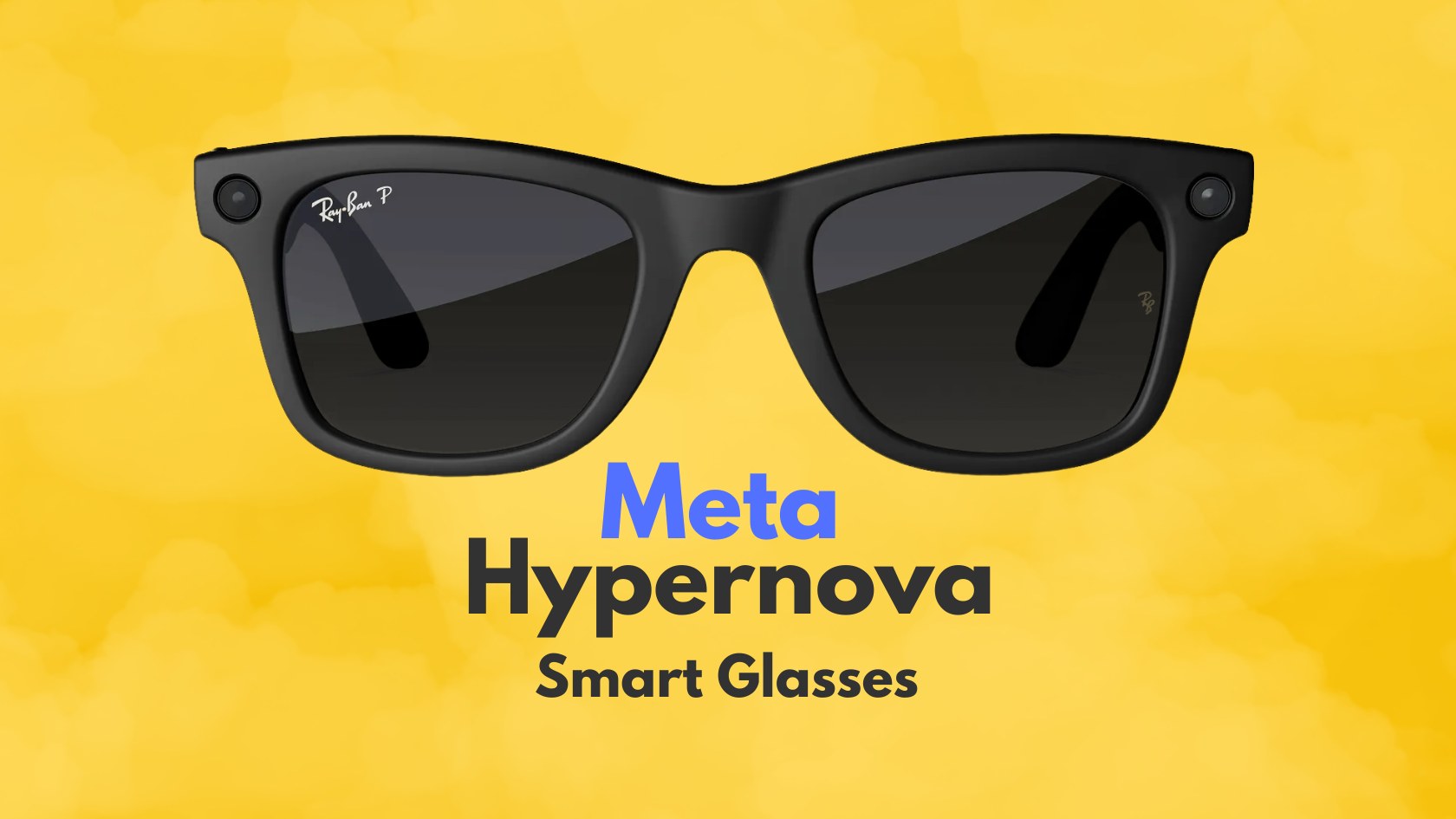A Giant Leap in Smart Wearable Technology
Meta is setting its sights on reshaping the way we see and interact with the world. The tech giant is reportedly preparing to launch a new, premium pair of smart glasses—codenamed Hypernova—by the end of this year. These futuristic shades go far beyond traditional eyewear, combining fashion with powerful, intelligent features. Designed as a follow-up to the Ray-Ban Meta smart glasses, which start at $299, the upcoming Hypernova glasses aim to redefine the mid-tier AR experience—offering features like gesture control, built-in apps, and a micro-display right in the lens.
According to Bloomberg, these glasses will cost significantly more, ranging between $1,000 and $1,400. Why the steep price tag? Hypernova is expected to bundle advanced capabilities including an upgraded camera, AI assistant integration, and Meta’s new neural wristband controller—setting it apart from most smart glasses currently in the market. Let’s dive into the upcoming features, design, pricing, and future plans for Meta’s smart wearable revolution.
Next-Gen Features: What Makes Hypernova So Smart?
The Hypernova smart glasses promise more than just hands-free calls and music. Unlike Meta’s first-generation Ray-Ban glasses, the new model includes a built-in micro-screen visible only in the lower right quadrant of the right lens. This discreet display provides essential information like app icons, photos, and home screen functions. The best part? Everything can be controlled using capacitive touch on the frame and intuitive hand gestures, removing the need to pull out your smartphone.
Users can access apps directly within the lens—an innovation that blends elements of smartwatches, AR headsets, and smartphones into one sleek accessory. The display orientation mimics Meta’s VR headset interface (Meta Quest), making it familiar for those already in the Meta ecosystem. This evolution in smart glasses design focuses on convenience, privacy, and real-time functionality—all accessible with just a glance downward.
In addition to visual feedback, Meta has continued integrating its AI assistant directly into the glasses. Whether it’s answering questions, translating signs, or offering navigation, the assistant is always “on,” right before your eyes. A truly immersive experience without needing to look down at your phone every few seconds.
Premium Design Meets High-Tech Utility
The upcoming Hypernova glasses are expected to carry a more refined and sturdy build compared to previous models. They will resemble traditional Ray-Bans in style but with hidden layers of advanced tech. From the outside, these shades look stylish and wearable in everyday settings—while hiding powerful hardware inside.
The improved onboard camera is another major enhancement. Early leaks suggest that it will support better resolution for photo and video capture, positioning Hypernova as a potential game-changer for creators and vloggers. The audio quality will also receive an upgrade to ensure clearer voice commands and improved media playback.
What really justifies the price, though, is the inclusion of Meta’s upcoming neural interface wristband, codenamed Ceres. This wearable device will allow users to control the glasses with subtle wrist movements. No need to speak or touch the frames—just a flick of your fingers will be enough to switch apps, scroll through content, or adjust settings. Combining glasses and a wrist controller pushes the limits of natural interaction and brings a true “Iron Man” tech feel into real life.
How Hypernova Stands Out from the Crowd
Smart glasses are nothing new, but Meta’s Hypernova takes a bold step toward practical, everyday use. Unlike full-blown AR headsets, which are often bulky and expensive, Hypernova fits into a familiar sunglasses design and focuses on ease of use. Think of it as the next evolution between normal glasses and augmented reality devices.
While devices like the Rokid AR Glasses and Nreal Air deliver green text and floating windows, they lack the tight integration, style, and AI capabilities Meta aims to provide. Hypernova caters to users who want more than basic functions without the complexity or discomfort of headsets. With its built-in screen, voice and hand gesture control, and neural wristband, Hypernova places itself in a category of its own.
Even though Meta is reserving full-fledged AR experiences for its future Orion glasses, which are still in development, Hypernova acts as a smart, stylish bridge toward that next chapter. It is for those who want innovation but are not ready for the bulk or price of high-end AR headsets.
Future Vision: What’s Next After Hypernova?
Meta is not stopping at just one pair of smart glasses. Plans are already underway for a successor—Hypernova 2—which is expected to launch around 2027. According to reports, this next-generation version will feature dual lenses with displays, enabling a more immersive AR experience that extends beyond peripheral use.
With Hypernova 2, Meta aims to close the gap between AR eyewear and true mixed reality headsets. This could mean more interactive experiences like real-time translation overlays, 3D object visualization, and even facial recognition features for smart social interaction. Meta seems determined to evolve smart glasses into daily digital companions that go beyond fun gimmicks to real-world functionality.
The wearable tech space is heating up, and Meta’s continuous innovation in this area suggests the company sees glasses as the future interface for AI and personal computing. The journey from Ray-Ban Meta glasses to Hypernova and beyond paints a roadmap for a world where screens might one day disappear from our hands and move entirely into our field of view.
FAQs: Everything You Need to Know About Meta’s Hypernova Glasses
Q1. When will Meta’s Hypernova smart glasses be released?
Meta is targeting a release by the end of 2025, though exact dates may vary depending on production and regional launches.
Q2. How much will the Hypernova glasses cost?
The expected price is between $1,000 and $1,400, depending on the final model and included accessories like the neural wristband.
Q3. What makes Hypernova different from other smart glasses?
Hypernova features a built-in screen, hand gesture controls, touch-sensitive frames, AI integration, and a neural interface wristband—making it more advanced than other mid-tier smart glasses.
Q4. Will Hypernova support apps?
Yes, it will support a number of apps and display them within the lens. It offers a home screen-like interface similar to Meta Quest VR headsets.
Q5. Is this an AR headset or regular smart glasses?
Hypernova is a smart glasses device with light AR features. It is not a full AR headset but includes micro-display and gesture capabilities.
Q6. What is Meta’s plan after Hypernova?
Meta is planning to release Hypernova 2 in 2027, which will feature dual-lens displays and further enhanced AR capabilities.
A Bold New Look at the Future
Meta’s Hypernova smart glasses represent a major shift in how we approach wearable tech. Stylish, powerful, and brimming with cutting-edge features, these glasses have the potential to redefine how we interact with the digital world. From subtle AI interactions to rich micro-display content and seamless gesture control, Hypernova feels like a sneak peek into the future—today.
As we edge closer to release, one thing is clear: Meta is serious about turning glasses into the next big interface. And if Hypernova delivers on its promises, you might just be seeing your next smartphone… right through your sunglasses.






















